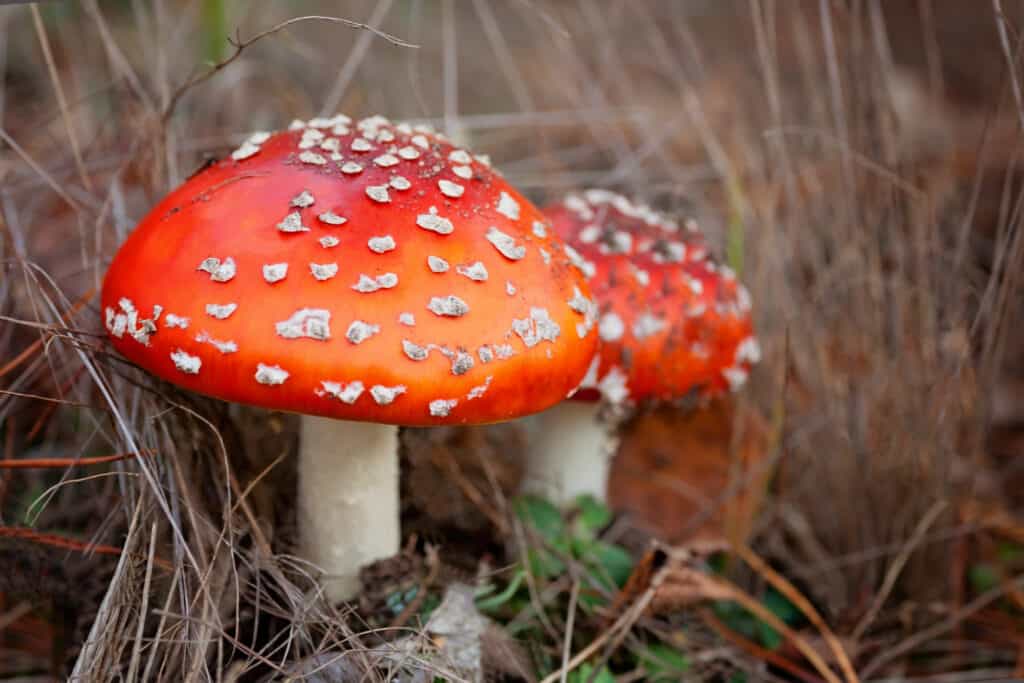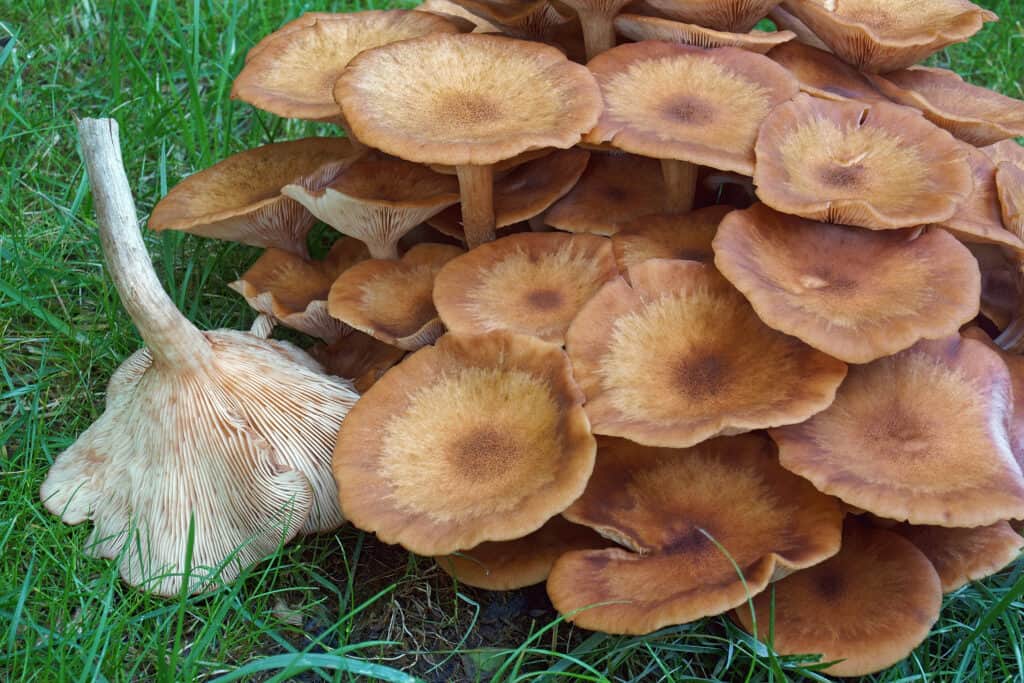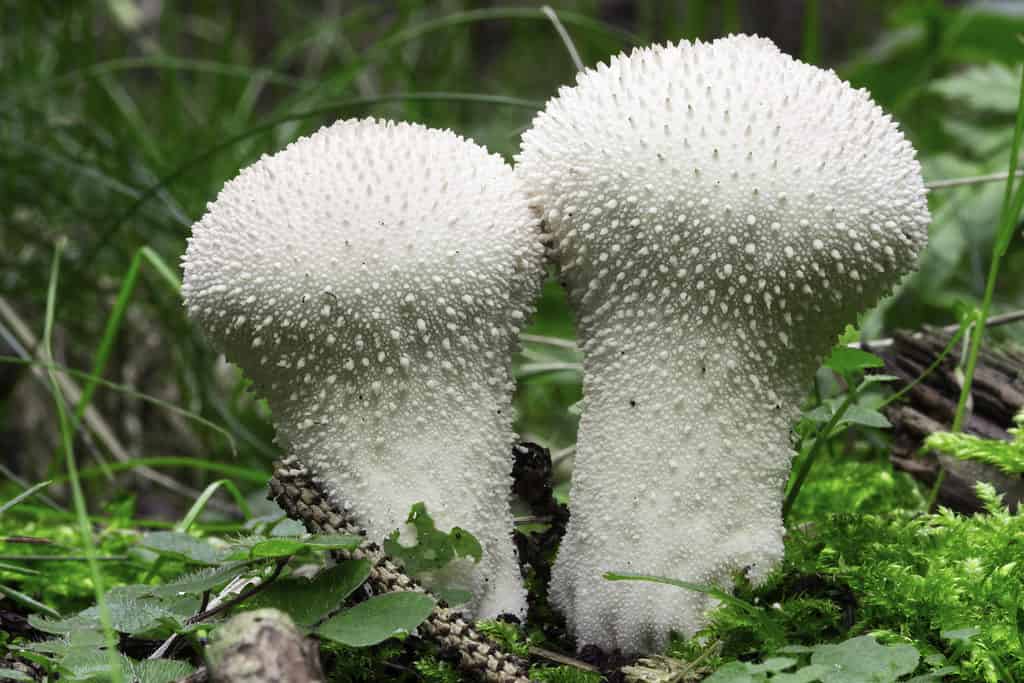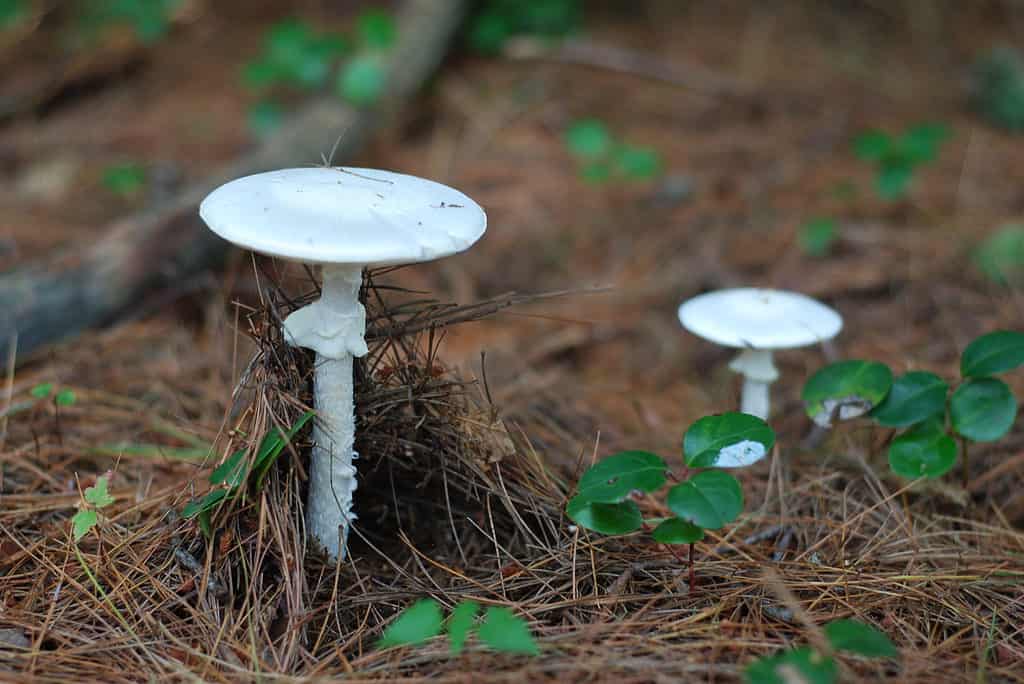If you have a flush of mushrooms growing in your backyard, you may be wondering if they’re poisonous or edible, and how you can tell? There’s no short answer to the question of backyard mushroom edibility as it totally depends on the species of mushroom in question.
Well, in this guide, we’ll discuss some identification tools to help you determine what species of mushroom is growing, general safe foraging practices, and more!
So, without further ado, let’s jump in!
Are Backyard Mushrooms Poisonous? Dispelling Quick ID Tip Myths
Right off the bat, it’s important to note that there are no true, quick identification tools to tell you if a mushroom is poisonous or not. Some popular myths say that poisonous mushrooms smell unpleasant, have white gills, or red caps. However, these statements are by no means universal truths.
Plenty of edible mushrooms have smells that you may find unpleasant, while some poisonous mushrooms may actually smell quite nice.
While many poisonous mushrooms in the Amanita genus have white gills, such as death caps and destroying angels, many edible mushrooms also have white gills. Remember, only about 2% of all identified mushrooms are truly poisonous to humans, and white gills are a common characteristic of hundreds of species. Examples of highly sought after edibles with white gills include the American and Japanese matsutake mushrooms.
While some well-known poisonous or hallucinogenic mushrooms have red caps, like Amanita muscaria (fly agaric) or Russula emetica (the sickener), several prized edible mushrooms also have red caps. This includes Sarcoscypha coccinea (scarlet elfcaps), Baorangia bicolor (bicolor bolete), and Fistulina hepatica (beefsteak mushroom).
So, the bottomline is that the only way to truly know if a backyard mushroom is poisonous is to properly identify it. If you don’t have the skill level to do so, another option is to send a sample of the mushroom to an expert to identify. Of course, you can always choose to not interact with or remove fruiting mushrooms in your backyard if you are unsure of its identification. However, it’s important to note that mushrooms play important ecological roles, and that the fruiting body is only the tiny above-ground, reproductive portion of the mushroom. The majority of the mushroom exists underground as mycelium.

(fly agaric) are well-known poisonous or hallucinogenic mushrooms that have red caps.
©iStock.com/aletheia97
Mushroom Identification: The Basics
Alright, you’ve found a flush of mushrooms growing in your backyard and now you’re eager to know what the species is and if they’re poisonous. Maybe you’re worried about your dog or children ingesting them, or maybe you’re hoping they’re edible.
First, you’ll need to have some basic mushroom ID tools to help you toward determining the species of mushroom growing. It’s important to note that recent estimates suggest there are around 5.1 million species of fungi in our world (possibly far more), and we’ve only formally identified about 150,000 of them. So, it’s entirely possible to have an unidentified species growing in your yard!
For species that have already been documented, expert mushroom identification sites and books exist that can help determine the species. Or, if you can’t identify the species, these resources may be able to help you identify the genus or family. If you’re wondering, “are my backyard mushrooms poisonous?”, we recommend checking out our article on our favorite mushroom books to get started.
What to Look For
When identifying a mushroom, you’ll need to look as some basic features. When using an online or in-print resource to aid in identification, you’ll need to note the following:
- The shape, color, size, and texture of the pileus/cap (top portion of the mushroom)
- If it has gills, pores, teeth, or is smooth under the cap.
- If it has gills, if and how are they attached to the stipe?
- Does a milky substance secrete from the gills?
- If a stipe is present (the stem), and it’s length, texture, color, brittleness, etc.
- Does it contain a partial or universal veil, a ring or material around the base?
- Is it hollow or fleshy inside?
- Does the fertile surface or the inside of cap or stipe turn a certain color when cut or bruised?
- Overall size
You’ll also want to note the following about it’s location and when you found it:
- Is it solitary or in a flush?
- Is it growing under or on a tree?
- Growing on a living tree or rotting log/stump, and what type?
- Growing in the soil?
- Growing from leaves?
- In the sun or shade?
- What time of year did you find it?
3 Common Backyard Mushrooms in North America
While you’ll need to positively ID the mushrooms in question to know for certain if your backyard mushrooms are poisonous, we can give you a list of three identified mushrooms that commonly grow in lawn-style backyards of North America.
1. Ringless Honey Mushrooms (Armillaria tabescens/Desarmillaria caespitosa)
Honey mushrooms are a common edible that appear in temperate regions across North America. The Armillaria genus of mushrooms have particularly expansive underground mycelium networks, and as such, typically produce rather large flushes of fruiting bodies. Some people consider honey mushroom flushes to be nuisances in their yard, but for people who enjoy foraging wild mushrooms, they are a highly anticipated Autumn treat!
Both ringed and ringless honey mushrooms are edible, but ringless honeys (Armillaria tabescens) more commonly appear in lawns, as long as a hardwood tree or stump exists in the yard or nearby. These mushrooms are parasitic and saprobic, meaning they can obtain their nutrients from living and decaying trees. Specifically for honey mushrooms, they obtain nutrients from the roots of hardwood trees.
During fall, these mushrooms will typically heavily flush a day or two after rainfall. Ringless honeys are delicious, but just make sure to cook them thoroughly as some people experience stomach upset when eating under-cooked honeys. To identify, look for honey-colored, dry, scaly caps. The caps are convex when young and flatten out with an uplifted margin as they age. You should see no ring around the stipe. These mushrooms grow in clusters. The stalks are thick and off-white to tan with a fibrous texture. Spore prints are white.

Ringless honey mushrooms (
Armillaria tabescens) grow in clusters and have convex caps when young which flatten and lift as they age.
©iStock.com/nickkurzenko
2. Common puffball (Lycoperdon perlatum)
Often seen growing on lawns in temperate regions across North America, common puffballs (Lycoperdon perlatum) are edible when young and are a pretty cute sight in lawns, as they look like little white cloud puffs, especially when young. When the flesh starts turning yellow inside, they are no longer edible. Some people stray away from foraging puffballs as they worry about confusing them with immature fruiting bodies of poisonous amanitas.
However, you can easily confirm a puffball versus immature amanita by cutting open the mushroom. The inside of a young puffball will be filled with a spongy, white interior and you will see no gills or slender stipe. With an immature amanita, the young mushroom is enveloped by an universal veil that covers the gills and stipe of the mushroom.

Common puffball (Lycoperdon perlatum) mushrooms are edible when young.
©gstalker/Shutterstock.com
3. Destroying Angel (Amanita bisporigera)
As its name suggests, destroying angels (Amanita bisporigera) are highly poisonous mushrooms that do grow on lawns across temperate regions of North America. You can identify these mushrooms by looking for an all-white mushroom with a slender, textured (cottony to shaggy) stipe, white gills, ring around the stipe (remnant of the universal veil), and egg-like sac covering the base of the stipe (part of the universal veil). The gills are freely or barely attached to the stipe. Gills are numerous and crowded. No milky substance should secrete from gills when pressed. Spore prints are white.

Amanita bisporigera, destroying angel mushroom.
©Jarek Tuszyński / CC-BY-SA-3.0, CC BY-SA 3.0 <https://creativecommons.org/licenses/by-sa/3.0>, via Wikimedia Commons – License
The Bottom Line
So, the answer to the question of “are backyard mushrooms poisonous?” is “it depends”. If you’re worried about a flush of mushrooms in your yard, the best course of action is to correctly identify the mushroom so you can make an informed decision on keeping or removing the mushroom fruiting bodies. If you aren’t confident in your identification skills, you can always send a sample of the mushroom to an mycology expert. Once identified, you can further research the mushroom to know how it relates in terms of the safety of your family and pets. While it certainly may be poisonous to people (about 2% of all identified species), it’s more likely that it is harmless or even edible.
Up Next
The photo featured at the top of this post is © Andrei Ksenzhuk/Shutterstock.com
The information presented on or through the Website is made available solely for general informational purposes. We do not warrant the accuracy, completeness, or usefulness of this information. Any reliance you place on such information is strictly at your own risk. We disclaim all liability and responsibility arising from any reliance placed on such materials by you or any other visitor to the Website, or by anyone who may be informed of any of its contents. None of the statements or claims on the Website should be taken as medical advice, health advice, or as confirmation that a plant, fungus, or other item is safe for consumption or will provide any health benefits. Anyone considering the health benefits of particular plant, fungus, or other item should first consult with a doctor or other medical professional. The statements made within this Website have not been evaluated by the Food and Drug Administration. These statements are not intended to diagnose, treat, cure or prevent any disease.
Sources
- ScienceDirect, Available here: https://www.sciencedirect.com/topics/agricultural-and-biological-sciences/poisonous-fungi
- National Library of Medicine, Available here: https://pubmed.ncbi.nlm.nih.gov/21613136/
- MushroomExpert.com, Available here: https://www.mushroomexpert.com/armillaria_tabescens.html
- Kitsap Peninsula Mycological Society, Available here: https://kitsapmushrooms.org/edible-mushrooms/common-puffball/
- Missouri Department of Conservation, Available here: https://mdc.mo.gov/discover-nature/field-guide/destroying-angel
Thank you for reading! Have some feedback for us? Contact the AZ Animals editorial team.






